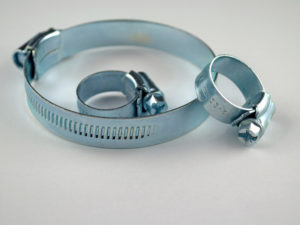 Hose clamps are generally used by auto, boat, and plumbing professionals to fix issues with loose or poorly fitted pipes, but you don’t have to be an expert to use hose clamps in your home. In fact, these simple tools can come in handy in all sorts of unexpected ways, which is why no toolbox is complete without a few spare hose clamps.
Hose clamps are generally used by auto, boat, and plumbing professionals to fix issues with loose or poorly fitted pipes, but you don’t have to be an expert to use hose clamps in your home. In fact, these simple tools can come in handy in all sorts of unexpected ways, which is why no toolbox is complete without a few spare hose clamps.
If you have a problem under your sink or with your garden hose, hose clamps are a viable solution. Here’s some general information on what hose clamps do and how to use them around your home.
What is a Hose Clamp?
Hose clamps are devices used to attach and seal a hose onto a fitting such as a barb. For example, if your garden hose is loose in its fitting, you may use an adjustable hose clamp to keep it fastened to the spigot. Thanks to their circular design, they’re designed to provide even pressure on all sides of a fitting, without any gaps. This ensures the hose stays in place and no leaks occur.
Are There Different Kinds of Hose Clamps?
Yes. There are several hose clamp types, which include worm gear, spring, and stainless steel hose clamps. Each clamp works a little bit differently, but ultimately they each operate under the same principle.
How Are Hose Clamps Used?
If you need to use a hose clamp, there are a few things you’ll need. First and most importantly, you’ll need a hose clamp. Before you start any project, however, you should make sure you have the right kind of clamp for the job. If you’re working on your car, you might need a spring clamp, but if you’re fixing a plumbing issue, you might want a worm gear clamp.
Once you have the right hose clamp, you’ll need a screwdriver. Using the screwdriver, expand the hose clamp and slide it over the hose. If you continuously turn the screwdriver, you’ll be able to open the hose clamp completely and skip the hassle of sliding it over the hose.
Once your clamp is in position around the fitting, use the screwdriver once more to tighten it until there are no signs of leakage and it stays firmly in place.
Remember: while you need a tight and secure fit, you don’t want to overtighten the clamp and risk breaking the hose altogether.
Hose clamps are available in a wide variety of materials and sizes, but for advanced home or auto repairs, you should always consult a professional to determine the best kind of tools for your situation.

